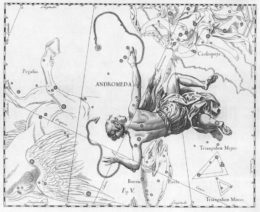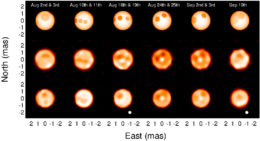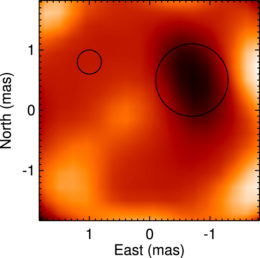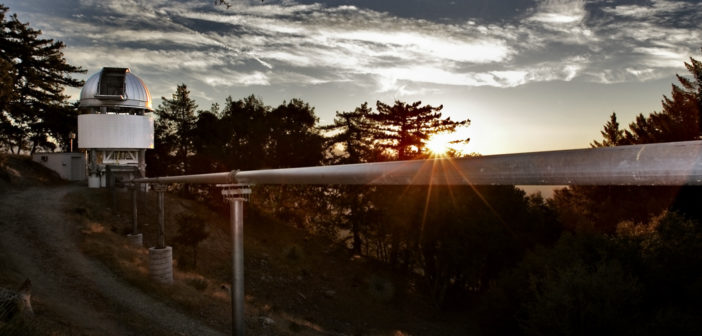Starspots are regions on the surface of a star that are cooler than their surroundings. Temperature affects brightness, so starspots can significantly alter the overall appearance of a star even when individual starspots can’t be distinguished. But if we characterize starspots in detail, we should be able to account for their effects.

The constellation Andromeda from Uranographia by Johannes Hevelius. λ Andromedae is just to the left of Andromeda’s thumb on her outstretched arm. [Torsten Bronger]
Old and New Ways of Finding Starspots
Starspots are thought to be caused by stellar magnetic activity, so as much as they can obscure true stellar properties, they can also help us learn about the interiors of stars. We’ve also noticed that our Sun’s starspots behave very differently than starspots on other stars, adding another motivation to examine these phenomena on other stars.
Until recently, starspots have been studied through indirect methods like light curve modeling and Doppler imaging, which measures changes in stellar spectra caused by magnetic fields. These techniques have broadened our understanding of starspots, but they are also hamstrung by requiring certain assumptions about the stars being observed.
Direct imaging of starspots has been made possible through a relatively new technique called long-baseline optical/near-infrared interferometry (LBI). A recent study led by James Parks (Georgia State University) uses this technique to observe starspots on λ Andromedae, a giant star in a binary with a less massive companion.

Stellar surface images based on observations taken in 2010. The top row is the starspot model images, the middle row is the observations, and the bottom row is the simulated images. The white dot is the resolution of the CHARA array, which was used to take the observations. The starspot models were constructed independently of the simulated images and vice-versa. [Parks et al. 2021]
Telescopes in Tandem
Interferometry is an imaging technique that combines the input of multiple telescopes as though they were a single, much larger telescope. LBI refers to interferometry conducted with telescopes that are spread out across a fairly large distance. For instance, the Event Horizon Telescope image of M87’s central black hole was taken by eight radio telescopes spread out across an entire hemisphere!
To image the starspots on λ Andromedae, Parks and collaborators used observations taken by the Center for High Angular Resolution Astronomy (CHARA) array, which consists of six 1-meter optical telescopes arranged in a Y-shape. The highest resolution allowed by these observations was 0.4 milliarcseconds (for context, the Moon spans roughly 0.5 degrees, or nearly 2 million milliarcseconds). Data was also taken on the 0.4-meter telescope at Fairborn Observatory to obtain light curves of λ Andromedae that were roughly concurrent to the LBI observations.

Close-up of a possible starspot in one of the image reconstructions. The larger circle indicates the region that was used to determine starspot properties, and the smaller circle indicates the region that was used to study the calmer surroundings of the spot. [Parks et al. 2021]
Two Different Ways to Model Starspots
Parks and collaborators used the CHARA observations to model λ Andromedae’s starspots in two different ways. The first method was to model the star’s surface while allowing for starspots, where the resulting models were informed by the CHARA observations. The second way was image reconstruction, which uses the observing conditions during which images were taken to determine the underlying astrophysical components. The advantage of using image reconstruction over surface modeling is that image reconstruction requires fewer assumptions about the object in question. However, false artifacts can be generated during the reconstruction process.
Both methods found between one and four starspots on λ Andromedae at any given time. The starspots also pointed to a rotation period that matched the period determined from the concurrent light curves. Overall, the study was a successful demonstration of using LBI to image starspots on λ Andromedae and, excitingly, more detailed studies are to follow!
Citation
“Interferometric Imaging of λ Andromedae: Evidence of Starspots and Rotation,” J. R. Parks et al 2021 ApJ 913 54. doi:10.3847/1538-4357/abb670


1 Comment
Pingback: From AAS NOVA : “Searching for Spots with Interferometry” | sciencesprings